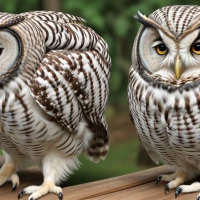Massachusetts, known for its rich history and stunning autumn foliage, is also a haven for birdwatching enthusiasts. Among the many winged wonders that grace the Bay State’s skies, owls hold a particular intrigue and mystique. These nocturnal raptors are not only symbols of wisdom and mystery but also key players in the local ecosystems. In this comprehensive guide, we dive into the enchanting world of the best owls in Massachusetts, providing an ultimate resource for birdwatchers and nature lovers alike. Prepare to embark on a journey through the Massachusetts night, as we reveal the secrets of these elusive predators.
Discovering Massachusetts’ Nocturnal Marvels
The Commonwealth of Massachusetts is host to a variety of owl species, each with their own unique characteristics and habitats. Owls are primarily known for their stealth hunting techniques, distinctive calls, and impressive head-turning abilities. Whether you’re a seasoned birder or just beginning to explore the avian world, spotting these creatures can be a thrilling experience. Here we explore the top eight owls that call Massachusetts their home.
The Great Horned Owl: Bubo virginianus
A Fearsome Predator of The Night
- Scientific Name: Bubo virginianus
- Size: 18-25 inches in length
- Wingspan: 3.3 to 4.8 feet
- Habitat: Woodlands, swamps, and forests statewide
The Great Horned Owl is one of the most powerful and adaptable owls found across North America and certainly a formidable presence in Massachusetts. Renowned for its deep hooting call, tufts of feathers resembling horns, and piercing yellow eyes, this owl is both breathtaking and intimidating. Here are some key observations:
- Hunting prowess: Equipped with sharp talons and a strong beak, the Great Horned Owl can take down prey much larger than itself, including other raptors.
- Nighttime activity: Like many owls, they are primarily active at night, leveraging their excellent night vision and hearing to hunt in the dark.
- Nesting: These owls do not build their own nests but rather take over the abandoned nests of other large birds.
The Eastern Screech-Owl: Megascops asio
The Camouflage Expert of Woodland Edges
- Scientific Name: Megascops asio
- Size: 6-10 inches in length
- Wingspan: 18-24 inches
- Habitat: Woodlots and suburbs with mature trees
Much smaller than the Great Horned Owl, the Eastern Screech-Owl boasts an uncanny ability to blend in with its environment. Its mottled pattern allows it to camouflage effectively against the bark of trees. Fascinating features of this species include:
- Color variants: This owl comes in two color morphs, red and gray, providing camouflage in different types of forests.
- Vocal range: Known for their haunting trills and whinnies, the Eastern Screech-Owl’s vocalizations add to the eerie beauty of Massachusetts’ nights.
- Adaptability: Its small size and adaptability allow it to thrive in a range of habitats, from the rural countryside to suburban gardens.
The Snowy Owl: Bubo scandiacus
A Winter Spectacle from The Arctic
- Scientific Name: Bubo scandiacus
- Size: 20-28 inches in length
- Wingspan: 4.2 to 4.8 feet
- Habitat: Open fields and coastal areas, usually during migration
Snowy Owls are striking creatures, with their brilliant white plumage and piercing yellow eyes standing out against the barren winter landscapes. Migrants from the Arctic tundra, they can be seen in Massachusetts during the winter months. Behaviors and traits include:
- Diurnal habits: Unlike many owls, Snowy Owls can often be seen hunting during the day, especially in their arctic summer season.
- Territorial: These owls defend their hunting areas fiercely from other birds and even from other Snowy Owls.
- Migration patterns: Their presence in Massachusetts typically coincides with the cyclic phenomenon known as an “irruption,” where they travel further south in search of food.
The Barred Owl: Strix varia
The Enigmatic Ruler of Swamps and Forests
- Scientific Name: Strix varia
- Size: 17-24 inches in length
- Wingspan: 39-43 inches
- Habitat: Dense woodlands, especially near water
With haunting dark eyes and a distinctive barred pattern on its chest, the Barred Owl is a common resident in Massachusetts’ wooded areas. Known for its “Who cooks for you?” call, the Barred Owl is both heard and seen more often than many other owl species due to its less secretive nature. Points of interest about the Barred Owl include:
- Hunting strategy: It silently swoops down from perches to capture small mammals and occasionally fish.
- Daytime activity: Though primarily nocturnal, Barred Owls are also frequently active during the day, especially during overcast weather.
- Conservation: Barred Owls have recently expanded their range but face challenges from habitat loss and competition with the similar Spotted Owl in some regions.
The Long-eared Owl: Asio otus
The Elusive Hunter of the Night Skies
- Scientific Name: Asio otus
- Size: 13-16 inches in length
- Wingspan: 35-40 inches
- Habitat: Dense coniferous forests and wooded thickets
The Long-eared Owl has distinct feather tufts that resemble ears, providing an impressive silhouette. Although it does breed in Massachusetts, this elusive owl is most often spotted during migratory periods. Some of its defining characteristics include:
- Roosting behavior: Long-eared Owls often roost communally during the non-breeding season, sometimes in groups of two or more.
- Flyer: Able to fly quite silently thanks to its feather structure, this stealth enables it to surprise prey.
- Diet: Its diet primarily consists of small mammals and it hunts mostly at dusk and dawn, using a combination of acute hearing and sight.
The Short-eared Owl: Asio flammeus
The Open-country Hunter with an Earthly Palette
- Scientific Name: Asio flammeus
- Size: 13-17 inches in length
- Wingspan: 33-43 inches
- Habitat: Open fields, airports, and grasslands
The Short-eared Owl, with its mottled brown plumage and piercing yellow eyes, is well adapted to open habitats. In stark contrast to the dense woodland preferences of other owls, the Short-eared Owl thrives in expansive, open areas. Their behavior includes:
- Ground nesting: Unlike many owls, the Short-eared Owl nests on the ground, camouflaged among the grasses and low vegetation.
- Diurnal activity: This species is one of the few owls that are commonly active during both day and night, particularly at dawn and dusk.
- Winter visitor: Though occasionally breeding in Massachusetts, the Short-eared Owl is usually seen in the winter when northern populations migrate southward.
The Northern Saw-whet Owl: Aegolius acadicus
The Miniature Marvel of Massachusetts’ Forests
- Scientific Name: Aegolius acadicus
- Size: 7-8.5 inches in length
- Wingspan: 16.5-22 inches
- Habitat: Dense coniferous or mixed forests, often near waterways
This diminutive owl, with its oversized head and big, round, yellow eyes, is arguably one of the most adorable owl species in the state. Despite its small size, the Northern Saw-whet Owl has a remarkable presence:
- Vocalizations: It has a distinctive high-pitched too-too-too call that can be heard mainly during the breeding season.
- Prey: Feeding mostly on insects and small rodents, its sharp talons are perfectly suited for grabbing quick-moving prey.
- Migration: While some remain year-round, others migrate to and from their breeding grounds, passing through Massachusetts in the process.
The Barn Owl: Tyto alba
The Iconic Ghost-face of Massachusetts’ Farmlands
- Scientific Name: Tyto alba
- Size: 13-15 inches in length
- Wingspan: 31-37 inches
- Habitat: Open country, farms, barns, and fields
With a face that seems to glow in the night, the Barn Owl is easily distinguished from other owls by its heart-shaped facial disc. They are less common in Massachusetts compared to other regions but still present an opportunity for thrilling sightings:
- Nocturnal hunting: Using its exceptional hearing, the Barn Owl locates prey in total darkness, flying low over fields to snatch up small mammals. Conservation status: Considered a species of special concern in Massachusetts, the Barn Owl’s populations are sensitive to harsh winters and loss of habitat. Calls and shrieks: Lacking the typical hooting call of other owls, the Barn Owl emits raspy shrieks and hisses that add to its eerie persona.
Conclusion: The Splendid Owls of the Bay State
The owls of Massachusetts play a crucial role in the state’s biodiversity, providing natural pest control and acting as indicators of environmental health. Their silent flight, nocturnal habits, and cryptic plumage have made owls a beloved subject of myth and legend, as well as conservation efforts. For birdwatchers and wildlife enthusiasts, the allure of spotting one of these crepuscular creatures is a never-ending quest, filled with the anticipation of peering into the soulful eyes of these natural-born hunters.
As we strive to craft a future where humans and wildlife coexist harmoniously, appreciating and understanding these majestic Birds of Prey becomes all the more important. Remember to observe these magnificent birds responsibly, minimizing disturbance to their habitats. With patience and respect, the haunting call or shadowy figure of a Massachusetts owl may just grace your presence, leaving an indelible imprint that echoes the untamed spirit of nature itself.










